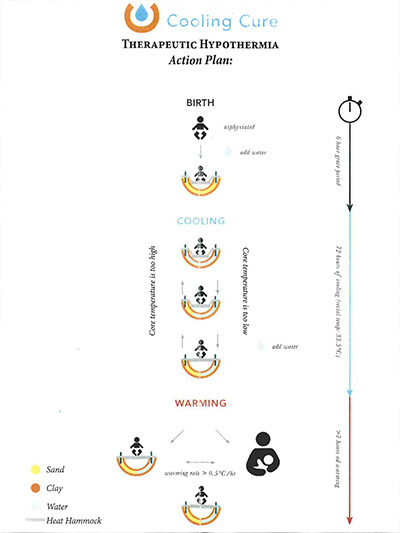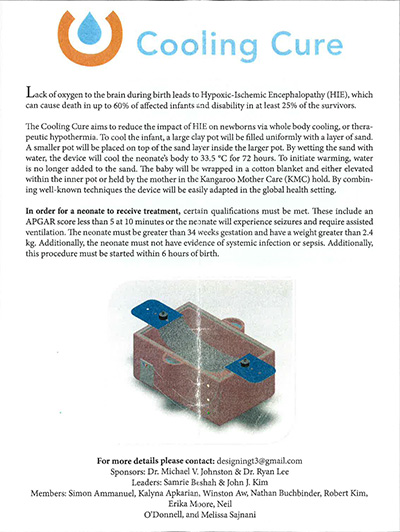Design Day 2012 - Center for Bioengineering Innovation & Design
May 7, 2012
The Cooling Cure: Toward Reducing the Long Term Effect of Newborn Birth Asphyxia
Clinical Advisors: Michael Johnston, MD, and Ryan Lee, MD, Kennedy Kreiger, Jhpiego
Student Team: Samrie Beshah, John J. Kim, Simon Ammanuel, Kalyna Apkarian, Winston Aw,
Nathan Buchbinder, Rober Kim, Erika Moore, Neil O'Donnell, and Melissa Sajnani
Lack of oxygen to the brain during birth leads to Hypoxic-Ischemic Encephalopathy (HIE), which can cause death in up to 60% of affected infants and disability in at least 25% of survivors. The Cooling Cure aims to reduce the impact of HIE on newborns via whole body cooling or therapeutic hypothermia. A specific procedure for hypothermia treatment includes the following crucial steps: lowering the neonate's core body temperature to 33.5 degrees celcius within the first 6 hours following birth, maintaining the 33.5 degrees celcius for 72 hours, and then gradually rewarming to 37 degrees celcius at a maximum rate of 0.5 degrees celcius per hour. To cool the infant, the "pot-on-pot" refrigeration method is employed through the use of clay pots. The larger clay pot will be filled uniformly with a 2 cm layer of sand. A smaller pot will be placed on top of the sand layer inside the larger pot. By wetting the sand with water, the device will maintain the inner pot temperature at 17 degrees celcius and thus the neonates body will be cooled. To initiate warming, water is no longer added to the sand. The baby will be wrapped in a cotton blanket and either elevated within the inner pot or held by the mother in a Kangaroo Mother Care (KMC) hold. By combining well-known techniques with the hypothermia treatment, the device will be more easily adapted in the global health setting.
The Cooling Cure Video


